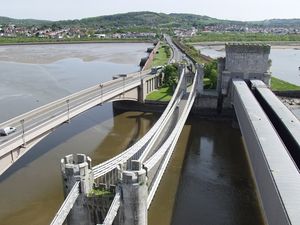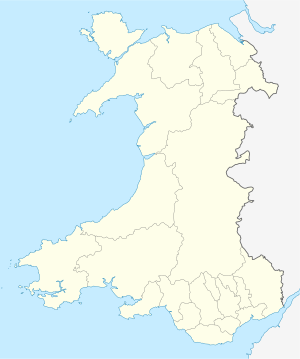Conwy Suspension Bridge
Coordinates: 53 ° 16'50 " N , 3 ° 49'25" W.
| Conwy Suspension Bridge | ||
|---|---|---|
| The Conwy Suspension Bridge in the middle | ||
| use | only pedestrian bridge | |
| Crossing of | River Conwy | |
| place | Conwy | |
| construction | Chain bridge | |
| Longest span | 99.7 m | |
| start of building | 1822 | |
| completion | 1826 | |
| planner | Thomas Telford | |
| toll | Entrance fee | |
| location | ||
|
|
||
The Conwy Suspension Bridge in Conwy on the north coast of Wales ( Great Britain ) is one of the oldest chain bridges still in existence .
history
After the unification of Ireland with the Kingdom of Great Britain by the Act of Union 1800 , trade between the two countries grew rapidly. Thomas Telford was commissioned to build the road from London via Bangor as well as the Menai Bridge to the Isle of Anglesey and the road to the main connecting port of Holyhead . Shortly thereafter, Telford was also commissioned to build the road from Chester via Conwy to Bangor, thereby building a bridge over the River Conwy . The tidal flow could then only be crossed by ferry to.
The Conwy Suspension Bridge was built between 1822 and 1826 on a narrow part of the river, dominated by Conwy Castle , between the castle and a flat rocky ridge protruding far into the river. The road leading over the bridge leads directly to the castle and only turns below the castle wall towards the village. The chain bridge now stands between Robert Stephenson's Conwy Railway Bridge , which opened in 1849, and a concrete bridge from 1958 that took over the increased traffic.
Between the chain bridge and the box girder of the railway bridge there was at times a narrow suspension bridge for pedestrians, which can only be seen on old views.
description
The Conway Suspension Bridge is around 170 m long. Their chains are anchored in the rock at the eastern end, but inside the castle at the western end, for which part of the castle wall had to be torn down. Its pylons each consist of two round towers with battlements, based on the style of the castle. They are made of limestone masonry. For stiffening purposes, the two towers of a pylon are connected by a wall that has a 3 m wide portal for traffic on the bridge. The towers are 12.2 m high and 3.75 m in diameter.
The bridge has 4 chains one above the other on each side, each of which consists of 5 wrought-iron eye sticks , 2.75 m long, arranged side by side . The connecting joints of the eye rods are staggered so that the iron rod hangers, which are arranged at a distance of 1.5 m, are alternately attached to different chains. The chains are still the original chains supplied by William Hazledine from his forge . When the bridge was strengthened in 1896, a thinner chain of two rows arranged next to each other with 2 eye-poles each on top of each other was built in.
The Conway Suspension Bridge has a span of 99.7 m (327 ft ). The deck girder originally consisted of an iron frame with crossbars, which was covered with wooden planks. In 1896 the track was replaced and the frame reinforced. The iron railings consist of lattice girders and thus have a stabilizing effect on the bridge deck. The current railings are from the 1990s.
At the eastern entrance to the bridge, there is still the original toll house, also decorated with turrets and battlements.
1950, the bridge and was Grade I building under conservation observed. In 2003 it was included in the List of International Historic Civil Engineering Landmarks by the Institution of Civil Engineers and the American Society of Civil Engineers . The bridge has been under the National Trust since 1965 .
Web links
- Conwy Castle with the bridge , steel engraving from around 1830
- Conwy Suspension Bridge , steel engraving from about 1830
- Historic photo of the bridge with cars and the neighboring small suspension bridge
Individual evidence
- ^ Conwy Suspension Bridge on Engineering Timelines
- ^ Conwy Suspension Bridge, Conwy on the British Listed Buildings website
- ↑ Photo of the memorial plaque
- ↑ a b The two steel engravings are taken from the following website: Old Photos of North Wales / Engravings of the Places in the County of Caernarvonshire - 1830
- ↑ The historical photo is taken from the following website: Anglesey Môn Information Website, Conwy (Conway) in North Wales, Photograph Archives Page 4.


